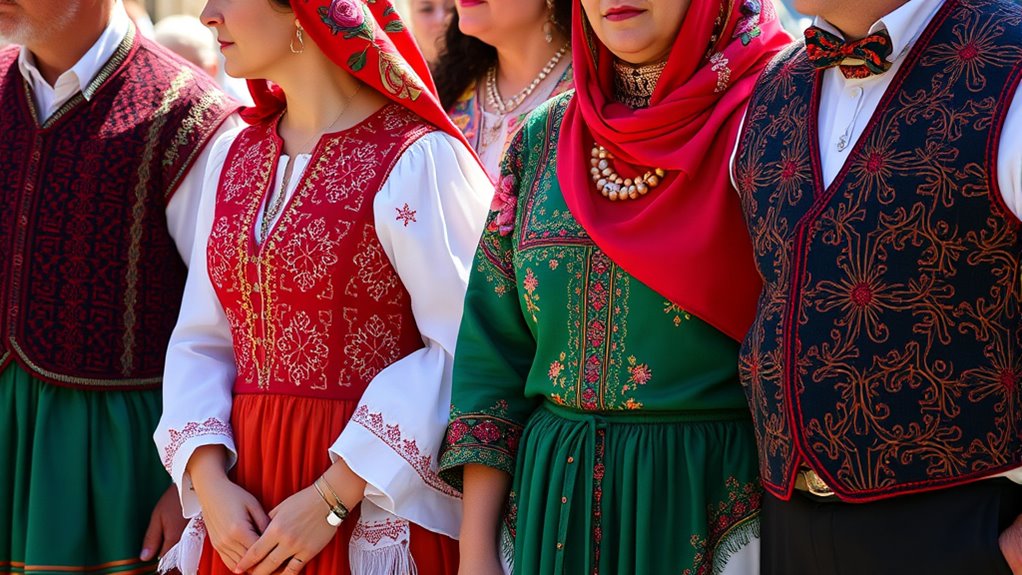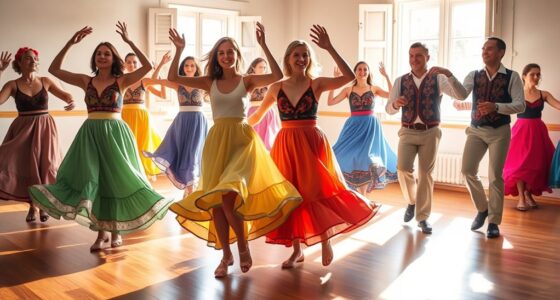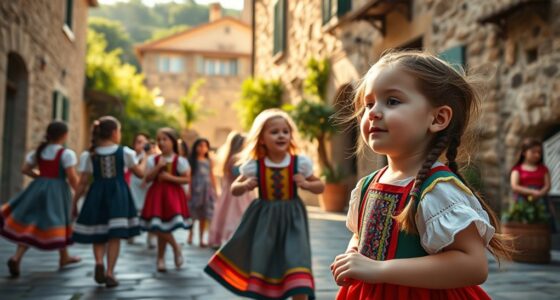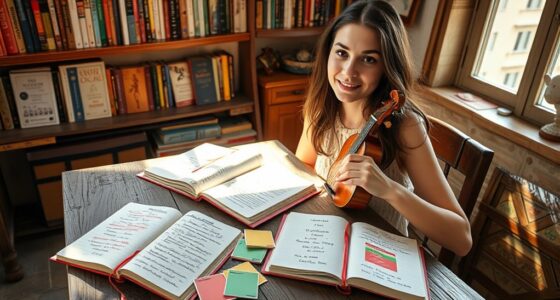Sardinian folk costumes showcase vibrant colors and detailed patterns that highlight regional identity and cultural history. You’ll notice bright shades like red, blue, and white, each symbolizing passion, peace, or purity. Embroidery techniques such as Punt ‘e Nù add textured, symbolic motifs like diamonds and flowers. Different regions feature unique headdresses, fabrics, and accessories, revealing social status and traditions. Keep exploring to uncover even richer meanings behind these stunning patterns and colors.
Key Takeaways
- Sardinian folk costumes feature regional color palettes reflecting local traditions, with bright, earthy, or pastel shades indicating specific areas.
- Colors like red, blue, black, and white carry symbolic meanings such as passion, peace, mourning, or purity.
- Embroidery motifs, such as diamonds, crosses, and floral patterns, use contrasting threads and geometric designs to enhance visual storytelling.
- Headdresses and accessories often incorporate color-coded elements signifying marital status, social role, and regional identity.
- Patterns and colors are used to depict cultural symbols, natural elements, and social signals, maintaining regional and community distinctions.
Regional Color Palettes and Their Meanings
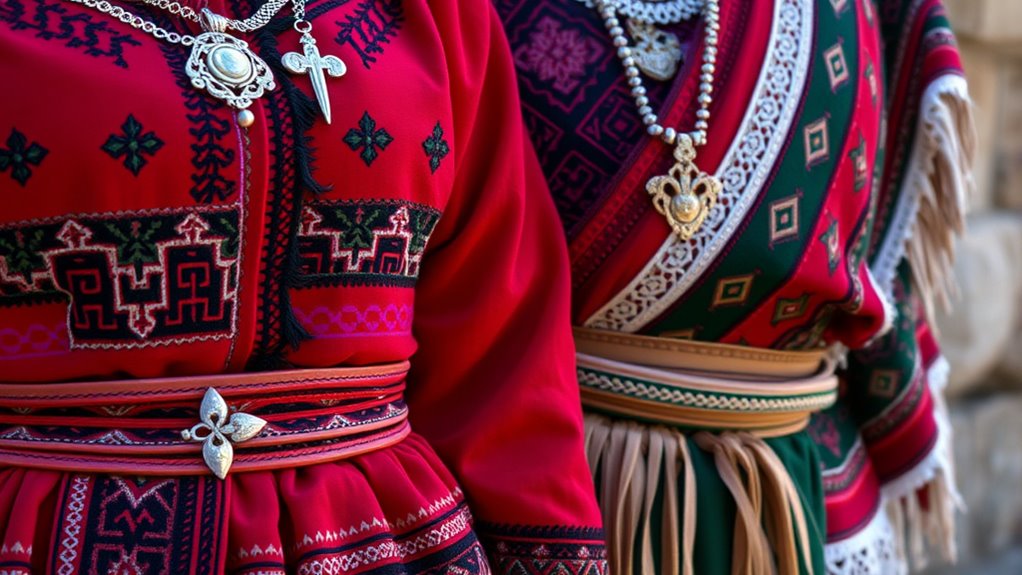
Sardinian folk costumes showcase a rich diversity of regional color palettes that reflect local traditions and history. You’ll notice significant variations across regions, each with its own symbolic hues. For example, Oristano’s vibrant colors and intricate designs highlight its cultural richness, while Ogliastra’s earthy tones mixed with brighter shades symbolize harmony with nature. In Medio Campidano, earthy hues echo agricultural roots, and Carbonia-Iglesias’s blue and white nod to Spanish influences. Cagliari features bright and pastel shades, mirroring its cosmopolitan vibe. Colors carry meanings—red for passion and celebration, blue for peace, green for fertility, and black for mourning. These palettes, combined with patterns and textures, reveal the region’s history, social status, and community identity, making Sardinian costumes a vibrant tapestry of tradition. Additionally, color symbolism plays a crucial role in conveying social and cultural messages within each community.
Embroidery Techniques and Iconic Motifs
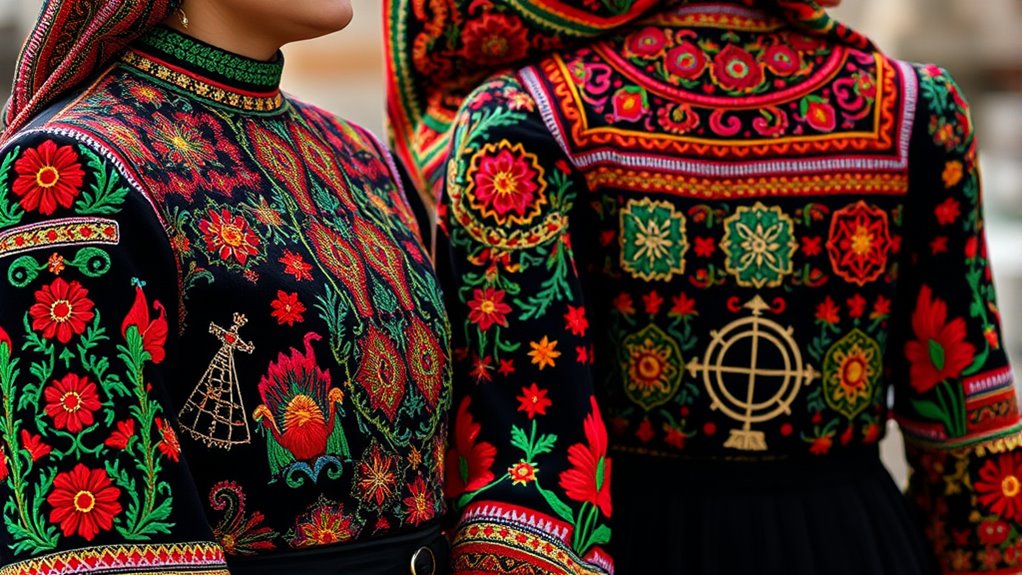
Embroidery plays a central role in shaping the distinctive look of Sardinian folk costumes, with techniques that emphasize texture and symbolism. The Sardinian Knotted Embroidery Technique, known as Punt ‘e Nù, uses a coral knot stitch to create lacy, textured geometric patterns in white-on-white designs. Originating in Teulada, it involves precise stitch directions—vertical, diagonal—that often join or overlap motifs, requiring careful thread management. This technique produces a raised, delicate texture on linen or cotton fabrics. The stitches are often worked in a specific sequence to ensure the stability and symmetry of the motifs, Iconic motifs include diamonds, crosses, stepped patterns, and stylized flowers and leaves, all often in abstracted geometric forms. These motifs carry symbolic meanings linked to local customs and spirituality. Embroidery is mainly found on sleeves, skirts, and aprons, adding rich texture and intricate detail to Sardinian costumes.
Structural Elements of Sardinian Costumes
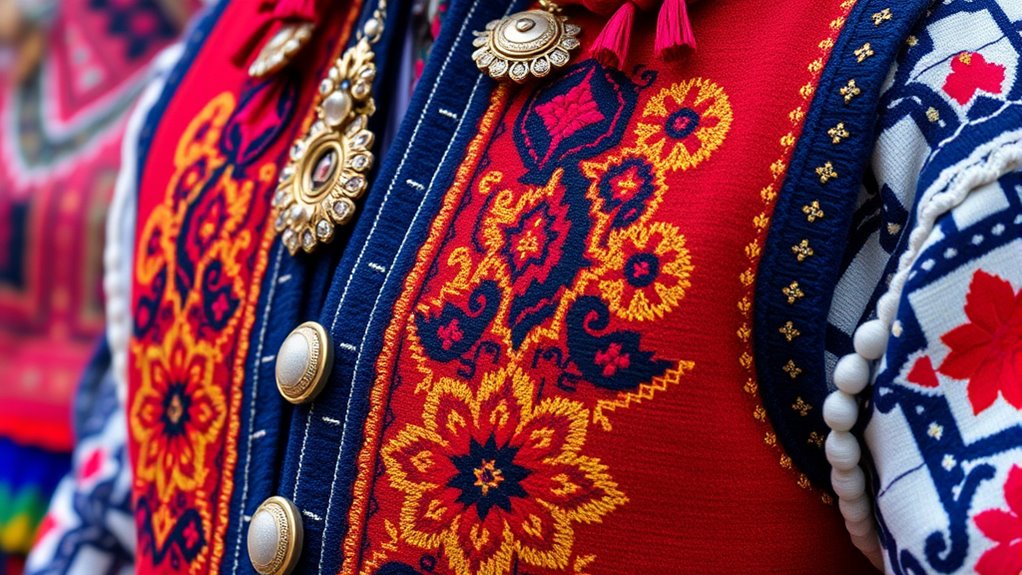
The distinctive look of Sardinian folk costumes relies heavily on their structural design and choice of fabrics. You’ll notice that they are built with layers, starting with simple undergarments that support more elaborate outer pieces. The base fabrics come mainly from sheep’s wool, like orbace, prized for its durability and water resistance, especially in outer garments. Women’s costumes typically feature wide skirts, blouses, reinforced jackets or corsets to shape the silhouette, and decorative aprons. The waist is cinched with belts or sashes often adorned with motifs, while stiffened edges and padding emphasize shoulder and waist contours. Men’s garments include coarse wool cloaks and fitted trousers, designed for practicality. These structural elements create a recognizable silhouette, reflecting regional identity and artisanal craftsmanship, which is evident in the precise tailoring and detailed embroidery that adorn these costumes.
Symbolism Behind the Color Choices
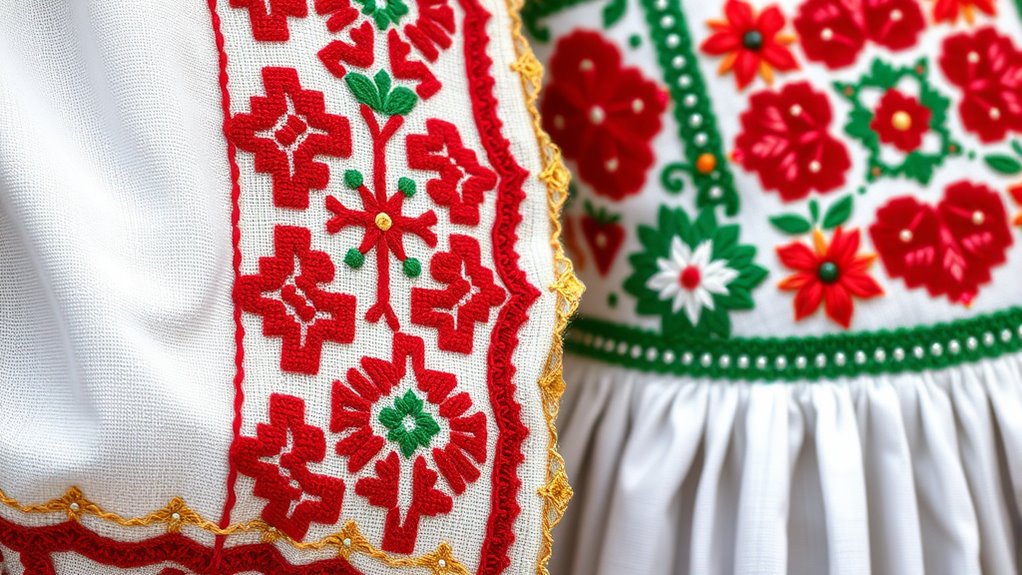
Colors in Sardinian folk costumes serve as powerful symbols that convey social status, regional identity, and cultural values. Bright, vivid hues, especially in women’s dresses, symbolize festivity, fertility, and prosperity. Red indicates vitality and protection, reflecting strength and valor, while black often signifies formality and dignity, providing a backdrop for embellishments. White represents purity and links to the region’s fine linen tradition. Each village employs unique color combinations and patterns, acting as a color-coded locator of local origins and cultural affiliations. These choices also symbolize natural elements and motifs, reinforcing messages of fertility and protection. Additionally, specific colors and arrangements signal marital status, social respect, and personal milestones, embedding social meaning into every stitch and shade. The use of color symbolism in costumes emphasizes the deep connection between visual aesthetics and cultural identity.
Distinctive Accessories and Ornamentation
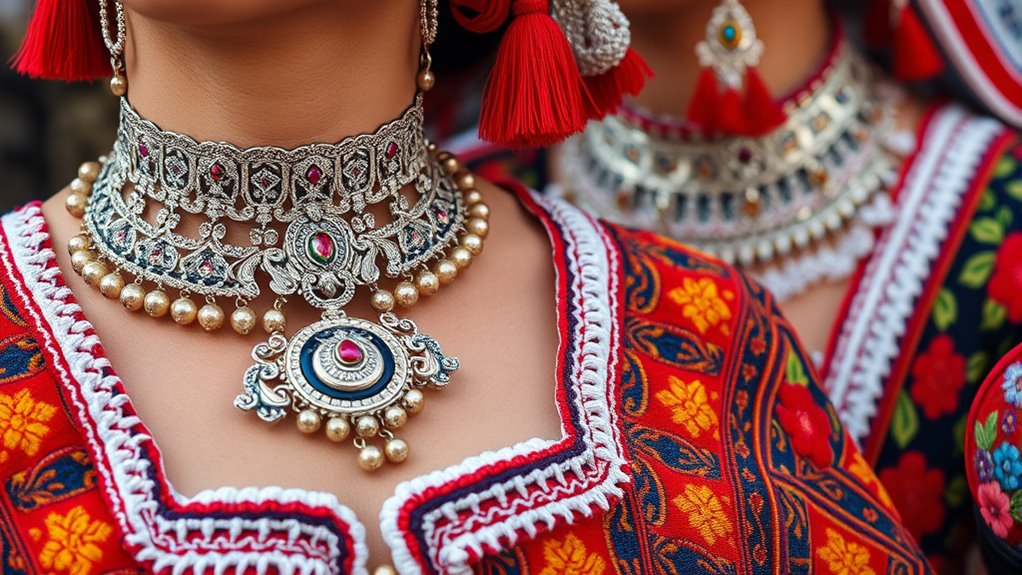
Distinctive accessories and ornamentation play a crucial role in defining Sardinian folk costumes, serving as visual markers of identity, social status, and regional pride. Headgear varies by region, from the lace *mucadore* to elaborately embroidered shawls for special occasions. Married women wear distinct headscarves, often rolled and arranged at different angles, with cross motifs symbolizing cultural values. Jewelry, mainly gold or imitation, includes layered necklaces, intricate braid-like chains, and decorative fastenings that highlight wealth and community ties. Embroidery on bodices and shawls features geometric and symbolic patterns unique to each village, showcasing artisan skill. Belts and waist sashes, often decorated or embroidered, define the silhouette and indicate social or ceremonial importance. These accessories embody tradition, craftsmanship, and regional identity. Traditional Sardinian costumes incorporate vibrant colors and intricate patterns that reflect local heritage and history, emphasizing the community’s pride in their cultural legacy.
The Influence of External Cultures on Styles
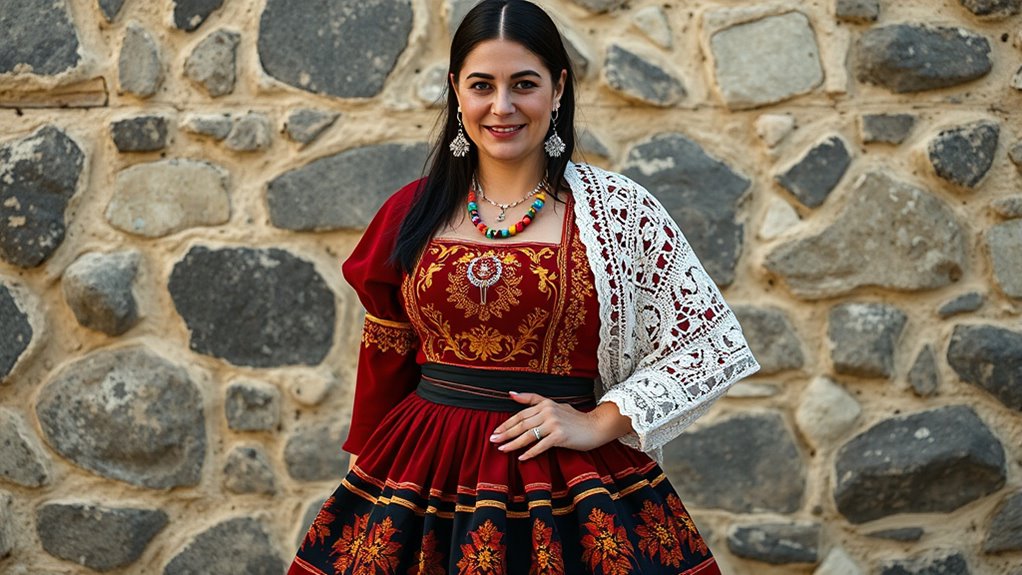
External cultures have profoundly shaped Sardinian folk costume styles, blending foreign influences with local traditions to create distinctive regional looks. You’ll notice three main influences:
External cultures have deeply influenced Sardinian folk costumes, blending foreign styles with local traditions to create unique regional identities.
- Spanish influence, seen in vibrant colors, luxurious fabrics like silk, and layered shapes reflecting 16th-18th-century fashions, along with embroidery motifs.
- Moorish and Mediterranean elements, evident in vivid decorations, geometric patterns, and weaving techniques inspired by Islamic art traditions.
- Ancient Mediterranean and Nuragic roots, preserved through symbols, earthy colors, and textile practices that connect to Sardinia’s prehistoric past.
- Additionally, the use of glycolic acid in skincare products has gained popularity for enhancing skin texture and radiance, demonstrating how external influences extend beyond fashion into beauty routines.
Rather than copying, locals adapted these styles using regional materials, simplifying or modifying designs to fit climate, social roles, and community identity. This fusion results in uniquely Sardinian costumes rich with history and regional variation.
Variations in Headdresses Across Communities
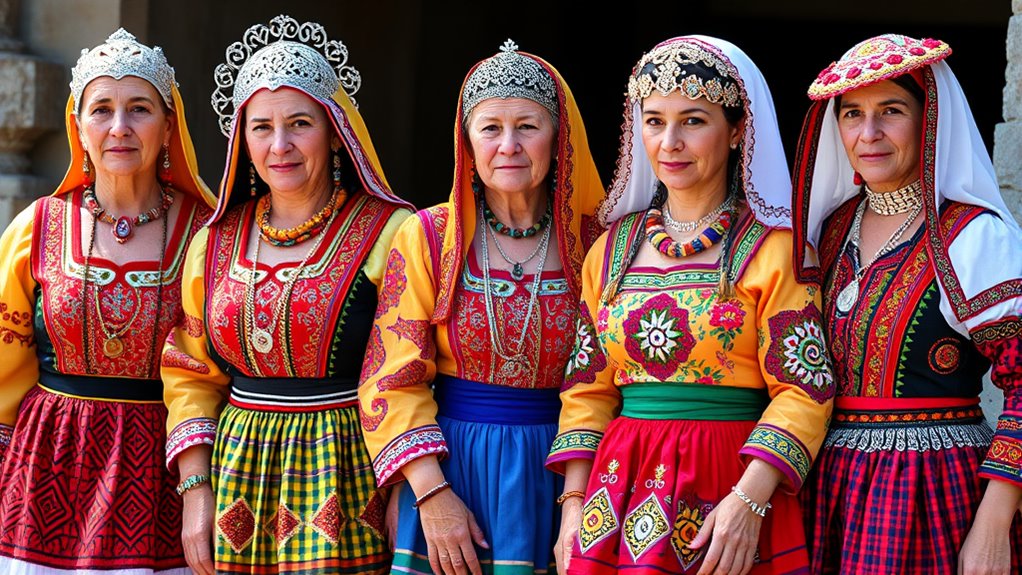
Headdresses serve as one of the most visible markers of regional identity in Sardinian folk costumes, showcasing a wide variety of styles across communities. Each village or town has distinctive features that reflect local traditions. For example, Orgosolo’s festive headdress includes saffron-dyed silk bandages with an Art Deco feel. Sennori’s gala headdress combines white mucarolu and elu for a layered look. Osilo’s occasion-specific head shawls are elaborately embroidered, while Samugheo’s headdress creates a complex multilayered cape from multiple handkerchiefs. Oliena’s style differs through unique shawl-wearing techniques. These variations often indicate marital status, age, or social role. The following table highlights some community differences:
| Community | Headdress Style | Key Feature |
|---|---|---|
| Orgosolo | Festive silk bandages | Saffron dye, Art Deco impression |
| Sennori | Layered white headdresses | Mucarolu and elu |
| Osilo | Embroidered shawls | Elaborate embroidery |
| Samugheo | Layered cape | Multiple handkerchiefs |
Additionally, the materials used in creating these headdresses often include locally sourced textiles and embellishments, emphasizing regional craftsmanship. Understanding the regional diversity of these costumes helps preserve Sardinia’s rich cultural heritage.
Fabric Selection and Its Cultural Significance
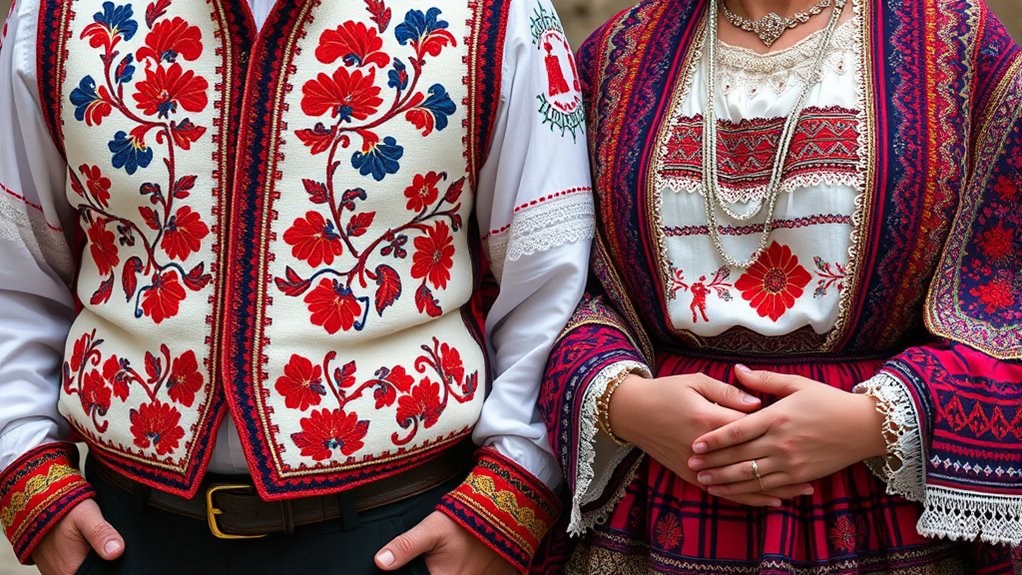
In Sardinian folk costumes, fabric choice plays a crucial role in expressing cultural identity and social significance. Your selection reflects not only practicality but also regional heritage and social standing. Here are key points to contemplate:
- Materials: Linen and cotton are common for everyday shirts, while silk and Orbachi are reserved for festive or ceremonial attire, indicating higher status.
- Colors: Traditional shades like black, red, blue, and white symbolize social roles, with red often representing vitality and protection.
- Regional Variations: Different towns preserve distinct textile traditions, showcasing local identity through unique fabric textures, patterns, and weaving techniques.
Your fabric choices serve as a living expression of Sardinian culture, marking occasions and social positions.
The Role of Embroidery in Social Status and Identity
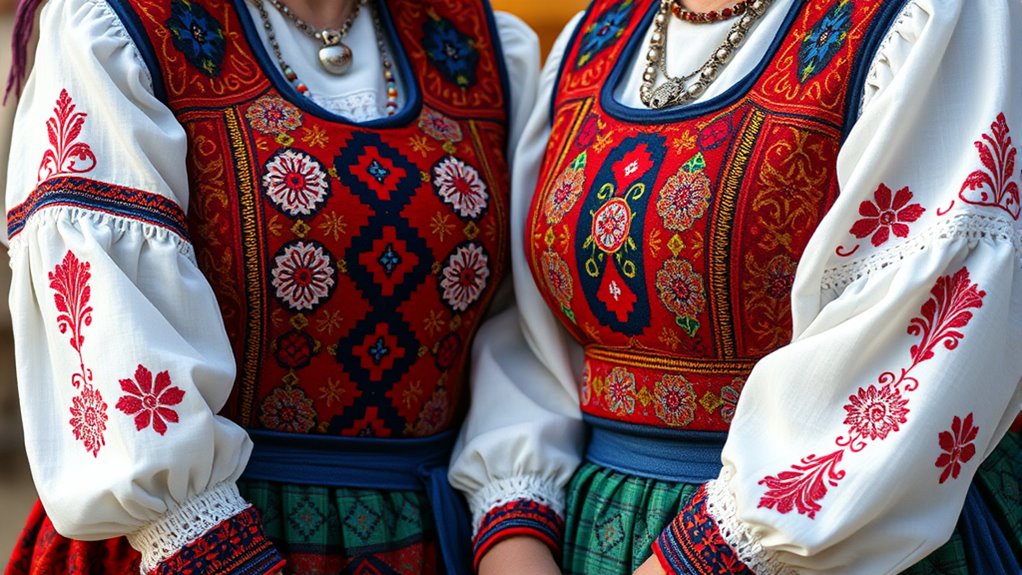
Embroidery in Sardinian folk costumes serves as a powerful indicator of social status and community identity. The complexity and style of embroidery reveal your social class and profession, with wealthier individuals wearing intricate designs using precious materials. Specific motifs and patterns communicate marital status—some reserved for married women, others for singles—while the embroidery’s quality highlights local elites or prominent community members. It’s also a marker of regional origin; each village’s unique motifs and colors reflect local history and cultural influences like Spanish or Moorish heritage. Embroidery patterns act as non-verbal communication, showcasing social roles, age, and connections to traditions. It embodies Sardinia’s layered history and preserves the cultural narrative, making your costume a visual story of identity and status.
Preservation of Traditional Patterns in Modern Times
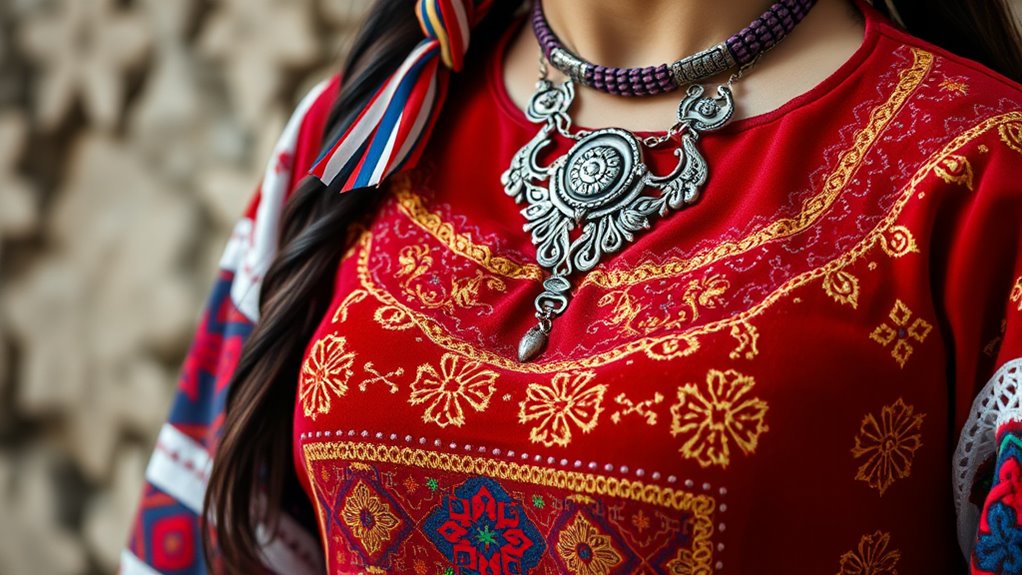
Communities across Sardinia actively work to preserve their traditional costume patterns through a combination of local craftsmanship and cultural pride. You’ll find artisans skillfully maintaining ancestral weaving and embroidery techniques, ensuring authenticity endures. Cultural festivals and events serve as platforms to showcase and celebrate these costumes, reinforcing their importance. Villages fiercely protect their unique designs as symbols of identity across Sardinia’s many towns. Every village maintains its own traditional costume, which helps keep these patterns alive and relevant today. To keep patterns alive, consider these efforts: 1. Supporting local artisans and craftsmen to transmit traditional skills. 2. Participating in workshops and markets that focus on heritage textiles. 3. Promoting museum exhibits and school programs that highlight the significance of these patterns. Additionally, the use of authentic materials is crucial in maintaining the integrity and traditional appearance of the costumes. Through these initiatives, Sardinian patterns continue to embody community identity and cultural resilience.
Frequently Asked Questions
How Do Sardinian Costumes Differ Between Urban and Rural Areas?
You notice that Sardinian costumes differ greatly between urban and rural areas. In cities, you see richer colors, fine fabrics, and elaborate embroidery that display social status and wealth. Rural costumes, on the other hand, use simpler, earthy tones and durable materials suited for daily work. They often feature practical designs, with traditional patterns that reflect regional origins and cultural rituals, especially during festivals and special occasions.
What Are the Common Symbols Embedded in Sardinian Embroidery Motifs?
You’ll notice that Sardinian embroidery motifs often embed symbols like fertility buttons, representing femininity and growth, and the *su coccu* amulet, believed to ward off negative energy. Farm life is reflected through sheep and land motifs, while natural elements show the island’s deep connection to nature. These symbols highlight cultural values, family bonds, and regional identities, making each embroidery piece a meaningful reflection of Sardinian heritage.
How Do Costume Styles Vary Between Different Age Groups?
Did you know that children’s costumes are often simpler and less decorated than adults’? You notice that costume styles change with age—kids wear practical, easy-to-move outfits, while young women’s costumes are colorful and elaborate, symbolizing vitality. As you see older people, their attire becomes more subdued and modest, reflecting wisdom and respect. These variations highlight age, social status, and cultural continuity within Sardinian communities.
Are There Seasonal or Festival-Specific Costume Variations?
You’ll notice that Sardinian costumes change with the seasons and festivals. In winter, costumes are heavier and darker for warmth, featuring woolen fabrics and thick accessories. During festivals, costumes become more elaborate, with bright colors, embroidery, and symbolic patterns. You might see masks, silver ornaments, and vibrant ribbons. These variations reflect local traditions, seasonal needs, and the cultural significance of each celebration, making each costume uniquely tied to its time and place.
How Has Modern Fashion Influenced Traditional Sardinian Dress Preservation?
You see how modern fashion influences traditional Sardinian dress by blending heritage with contemporary trends. You might wear embroidered shawls or jewelry inspired by ancient motifs, helping keep these crafts alive. You also support artisans who use age-old techniques, ensuring their skills aren’t lost. By embracing sustainable and ethical practices, you help promote the cultural importance of Sardinian costumes, making sure they stay relevant and appreciated in today’s fashion world.
Conclusion
As you explore Sardinian folk costumes, you discover a vibrant tapestry woven with history and meaning. Each color, pattern, and accessory acts like a brushstroke on a cultural canvas, telling stories of community, status, and tradition. By embracing these intricate elements, you maintain Sardinia’s heritage alive—like a river flowing through generations, carrying the beauty of the past into the future. Preserving these costumes ensures their vibrant spirit continues to inspire.
